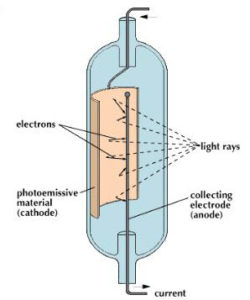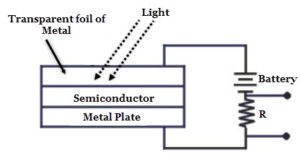Photoelectric cell is the device which converts light energy into electrical energy. Depending upon the different photoelectric effects employed, the photoelectric cells are of following 3 types.
- Photoemissive cell
- Photoconductive cell
- Photovoltaic cell
Photoemissive cell
This cell is based on the fact that electrons are emitted from a photo-sensitive surface by the action of light. Figure 1 shows the photoemissive cell. It consists of a photo-sensitive cathode (negative) and collecting anode (positive) enclosed in an evacuated glass envelope.
Cathode is coated with photo-sensitive material such as sodium, potassium or cesium. Anode is straight wire made of nickel or platinum.

image source: kids.britannica.com
Working
When light of frequency greater than threshold frequency is made to fall upon the cathode, photo-electrons are emitted from it. These photo-electrons are attracted by the positive anode to constitute current in the external circuit so long as the illumination is maintained.
When small amount of inert gas like argon is added in the glass envelope, it is called as gas-filled photoemissive cell. The presence of gas helps in obtaining more current for a given illumination due to ionisation of the gas.
Thus photoemissive cells are of two types
1. In the vacuum type cell, current starts immediately after the light is incident and is proportional to the intensity of incident light. Hence this cell is used for photometry and in televisions.
2. In gas filled cell, the current is somewhat larger and is not proportional to the intensity of light. Hence, this type of cell is most suitable in cinematography and in the recording and reproduction of sound.
Photoemissive cell Advantages
1. The emission is instantaneous.
2. The maximum current is proportional to the intensity of radiation.
3. High Sensitivity
Photoemissive cell Disadvantages
1. It generates extremely small current.
2. Direct power supply required for maintaining potential.
3. They are expensive.
Photoconductive cell
The photoconductive cell is a two terminal semiconductor device whose terminal resistance will vary (linearly) with the intensity of the incident light. Photoconductive cell is also known as light dependent resistor (LDR) and photoresistor.
This cell is based on the fact that electrical resistance of certain semiconductors such as Selenium, lead sulphide, etc., decreases when intensity of light falling on them increases. The photoconductive cell is shown in figure 2.


In this, a thin layer of semiconductor is placed below a transparent film of some metal. This combination is fixed over and iron plate. When light is allowed to fall on transparent film, the electrical resistance of the semiconductor layer gets decreased i.e. its electrical conductance is increased. Hans a current starts flowing in the battery circuit connected between iron plate and the transparent metal film. This current changes with change in intensity of incident light with a time-lag. This time-lag is the main defect of this cell due to which it is rarely used.
Photoconductive cells are preferred to photovoltaic cells when very sensitive response to changing light conditions is needed.
Photoconductive cell Applications
→Analog Applications
- Camera Exposure Control
- Auto Slide Focus – dual cell
- Photocopy Machines – density of toner
- Colorimetric Test Equipment
- Densitometer
- Electronic Scales -dual cell
- Electronic Scales -dual cell
- Automatic Gain Control – modulated light source
- Automated Rear View Mirror
→Digital Applications
- Automatic Headlight Dimmer
- Night Light Control
- Oil Burner Flame Out
- Street Light Control
- Absence / Presence (beam breaker)
- Position Sensor
Photovoltaic cell
It is based on the fact that when the region of contact between two specially prepared conducting surfaces is illuminated, a flow of current takes place. It differs from the other photoelectric cells in the respect that no external battery is used to accelerate the emitted photo-electrons as the cell generates its own e.m.f.
Photoelectric cell Applications
1. Photoelectric cells are used in the reproduction of sound in motion pictures.
2. Photoelectric cells are extensively used for switching ON or OFF lights automatically.
3. They are used in burglar’s alarm.
4. They are used to open and close the doors automatically.
5. They are used to detect the opacity of solids.
6. Photoelectric cells are used to control temperature in furnace and chemical reactions.
7. They are used in applications where automatic counting of parts manufactured by a machine or of the person entering a room.
8. Photoelectric cells are used in obtaining electric energy from sunlight.
